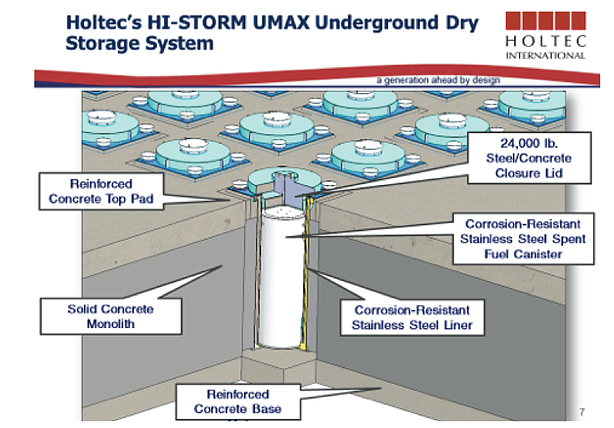The U.S. has a serious spent nuclear fuel problem. The cooling pools at U.S. nuclear power plants are rapidly filling up with spent nuclear fuel. There are about seventy thousand tons of spent nuclear fuel located at seventy sites in thirty-five states. In 1992, the U.S. government chose Yucca Mountain in Nevada for a permanent spent nuclear fuel geological repository to be in operation by 1999. In 2009 after millions of dollars had been spent on preparing the Yucca Mountain nuclear waste depository, the project was canceled over environmental concerns. The earliest we can expect to have a national permanent spent nuclear fuel disposal facility is 2050. In the meantime, spent nuclear fuel will have to be temporarily stored in concrete and steel dry casks either at the nuclear power plants or in one or more offsite national facilities.
Holtec International is proposing a consolidated interim storage facility (CISF) to be built in New Mexico. If their schedule is approved and successfully followed, they expect to start receiving shipments of spent nuclear fuel in 2020. In April, Holtec and Eddy-Lea Energy Alliance (ELEA) signed a memorandum of agreement that detailed the design, licensing, construction and operation of the proposed CISF. ELEA will supply the land and also local logistical support including existing information on the environmental characteristics of the land. The CISF will be based on Holtec's (Holtec International STORage Module Universal MAXimum security) or HI-STORM UMAX dry storage system.
Holtec is licensing its UMAX technology to store other manufacturers canisters as well as its own canisters. Holtec says that it has certification with the NRC for transporting casks that are in use today so if the NRC provides the licenses, Holtec could begin moving waste immediately. Their CIFS is built so that the spent fuel in any particular cask can be retrieved within four to eight hours. Holtec points out that the UMAX system is already in use at the Missouri Callaway nuclear power plant and was chosen for the San Onofre plant decommissioning in California so they consider it a proven technology.
The one thousand acre site being supplied by ELEA is about mid-way between Hobbs and Carlsbad. ELEA says that the site is remote, geologically stable, dry and is accessible by rail. The area that it is in already has a "robust scientific and nuclear operations workforce" with the Waste Isolation Pilot Plant near Carlsbad and several other nuclear facilities nearby. The new CISF will only require about sixty acres of the one thousand acre site.
Holtec will submit a letter of intent for the CISF to the Nuclear Regulatory Commission in August. Once the letter of intent from Holtec reaches the NRC, a pre-application meeting could be held in December followed by a formal application submittal in June of 2016. A safety evaluation report could be issued by the end of 2018 with a license to begin construction in 2019 and operations to begin in 2020. Holtec officials say that the main problem that they foresee with their proposal is political and they are working hard to gain local approval for their proposed facility. They are currently in discussion with the Department of Energy to see if the DoE is willing to be the official owner of the spent nuclear fuel to be stored at the CISF.
One of the biggest problems for the expansion of nuclear power in the U.S. is concern over the disposal of spent nuclear fuel. Holtec is hopeful that the existence of a safe temporary storage facility in New Mexico will help relieve this concern and stimulate the growth of U.S. nuclear power.
